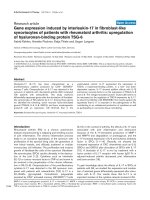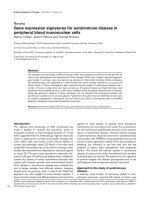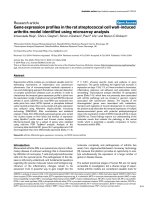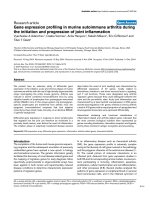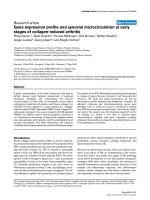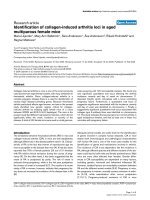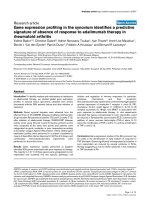Báo cáo y học: "Gene expression signatures for autoimmune disease in peripheral blood mononuclear cells" potx
Bạn đang xem bản rút gọn của tài liệu. Xem và tải ngay bản đầy đủ của tài liệu tại đây (649.89 KB, 9 trang )
120
IDDM = insulin-dependent diabetes mellitus; IFN = interferon; IL = interleukin; MS = multiple sclerosis; PCR = polymerase chain reaction; PBMC =
peripheral blood mononuclear cell; RA = rheumatoid arthritis; SDA = Symbolic discriminant analysis; SLE = systemic lupus erythematosus; SLEDAI =
SLE disease activity index.
Arthritis Research & Therapy Vol 6 No 3 Olsen et al.
Introduction
The relatively new technology of DNA microarrays has
made it feasible to measure the expression levels of
thousands of genes in small biological samples [1]. It has
been suggested that this methodology might be especially
useful in analyzing the complex and parallel changes that
occur within cells and tissues of the immune system in
normal and pathologic states [2]. Much of the early work
using DNA microarrays was in the field of oncology; other
studies have examined host responses to infectious agents
or drugs [3]. The gene array approach is especially well-
suited to the type of multifactorial analysis that is needed to
unravel the causes of human autoimmune disorders that
involve both complex genetics and environmental factors
[4,5]. Studies in autoimmune disease have included the
use of biopsy samples from affected patients, targeting
tissues such as synovium, brain or skin [6–9]. While this
approach can offer insights for some disease subsets, it
does not permit study of all afflicted patients and cannot be
applied to early phases of disease when therapeutic
interventions are most likely to be useful. As an alternative,
we and others have hypothesized that due to the systemic
nature of autoimmune disease, clinically relevant changes
in gene expression should be observed in peripheral blood
mononuclear cells (PBMCs). Using peripheral blood as the
source of gene expression material offers the possibility of
sampling any individual at any time and also has the
potential to detect early pathogenetic and prognostic
factors. This review will examine studies in autoimmune
disease, focusing on the utility of peripheral blood samples
to identify genes of interest. The potential for this approach
to provide insights into disease pathogenesis and to aid
with diagnosis and management are also discussed.
Approach to the study of autoimmune
disease
A relatively small number of microarray studies in auto-
immunity have been reported [3]. Some of these have
Review
Gene expression signatures for autoimmune disease in
peripheral blood mononuclear cells
Nancy J Olsen, Jason H Moore and Thomas M Aune
Division of Rheumatology, T-3219 Medical Center North, Vanderbilt University, Nashville, Tennessee, USA
Corresponding author: Nancy J Olsen;
Received: 10 Nov 2003 Revisions requested: 15 Jan 2004 Revisions received: 14 Apr 2004 Accepted: 21 Apr 2004 Published: 29 April 2004
Arthritis Res Ther 2004, 6:120-128 (DOI 10.1186/ar1190)
© 2004 BioMed Central Ltd
Abstract
The relatively new technology of DNA microarrays offers the possibility to probe the human genome for
clues to the pathogenesis and treatment of human disease. While early studies using this approach
were largely in oncology, many new reports are emerging in other fields including infectious diseases
and pharmacology, and applications in autoimmunity have been recently reported by our group and
others. Some of these investigations have examined animal models of autoimmune disease, but a
number of human studies have also been carried out. Of special interest are those that have used
peripheral blood samples because, unlike tissue biopsies, these are readily available from all subjects.
Using this approach, patterns of gene expression can be detected that distinguish patients with
autoimmune conditions from normal subjects. Furthermore, the genes that are identified provide clues
to possible pathogenetic mechanisms and are likely to be useful in developing tests to establish
diagnostic categories and predict therapeutic responses.
Keywords: autoimmune disease, DNA microarrays, gene expression, systemic lupus erythematosus
121
Available online />used animal models, such as for alopecia areata [7] and
experimental systemic lupus erythematosus (SLE) [10]. In
human autoimmunity, biopsy samples from tissues such as
rheumatoid synovium [6,9] and skin [7] have yielded
disease insights. Other groups of investigators have
concentrated on the possibility that peripheral blood might
show gene expression correlations with disease states
[11]. Six published reports have described results
obtained using microarray analysis of PBMC populations
from patients with various autoimmune disorders (Table 1).
Two of these studies were in multiple sclerosis (MS)
[12,13] and three were in SLE, including one that used
only juvenile subjects [14–16]. In a study from our own
laboratory, four different autoimmune diseases,
rheumatoid arthritis (RA), SLE, MS and Type-I or insulin-
dependent diabetes mellitus (IDDM), were studied [17].
The diseases represented in these reports span a broad
spectrum within the rubric of autoimmunity, including both
generalized (RA and SLE) and tissue-specific (MS and
IDDM) pathologies. Three of these syndromes (RA, SLE
and MS) show a female predominance, while IDDM in
humans has no significant gender dimorphism. Treatments
also differ, with RA and SLE usually requiring long-term
continuous immune suppression, while MS often shows
quiescent phases requiring no treatment and IDDM
therapies are for glucose control rather than immune sup-
pression. In most published studies, autoimmune samples
have been compared to unaffected control individuals who
are generally matched for the age and gender
characteristics of the study population. Our group also
investigated the relationship between a normal immune
response and the autoimmune response by examining
control subjects before and after routine influenza vaccina-
tion [17]. It is notable that in most of these reports, the
numbers of samples are relatively small, with significant
results reported using study groups of 10–20 subjects
each, indicating the strength of the multiparameter
approach to analysis of array data. Many investigators
have used frozen samples, which permit added flexibility
for approaches such as studies of longitudinal responses
to a therapeutic intervention [13].
While peripheral blood offers many advantages as a
source of analysis material, one potential drawback is the
small quantities of RNA that can be reasonably obtained.
Surprisingly, information about the amount of blood
needed to produce an analyzable sample has not been
uniformly reported; one group used lymphocytopheresis,
suggesting a need for large numbers of cells [12]. Early
chip protocols often required more than 25 µg of total
RNA, which could only be obtained by using large blood
volumes. This could be problematic, especially in studies
of children or seriously ill subjects. In our initial studies, the
gene filter from Research Genetics (now Invitrogen,
Carlsbad CA), which contained clones for approximately
4300 identified human genes, was chosen because only
5 µg of total RNA was required and we were interested in
testing the feasibility of analyzing small blood samples.
These gene filters are, however, no longer available. Current
recommendations for other platforms, such as the
Affymetrix Gene Chip Arrays
®
, require no more than 5 µg
total RNA, probably due to improved efficiency of the
labeling techniques, and this can be readily attained from
blood samples without amplification. Sample size, therefore,
is probably no longer a limiting factor in experimental design.
Methods for verifying data from microarrays have become
familiar to most users. Reproducibility has been achieved
Table 1
Gene expression studies of peripheral blood mononuclear cells from patients with autoimmune diseases
Subjects studied Gene arrays used Summary Reference
MS (n = 27) and normal 14,000 cDNA clones MS patients distinguished from normal Bomprezzi et al., 2003
controls (n = 19) controls using 53 discriminatory genes [12]
MS (n = 10) Mini-lymphochip with Identification of a set of genes regulated by Sturzebecher et al., 2003
>12,000 elements IFN-β [13]
SLE (n = 21) and normal Cytokine gene array with 375 Clustering distinguished most patients from Rus et al., 2002 [14]
controls (n = 12) genes in duplicate controls
SLE (n = 48) and normal Affymetrix U95A array with Dysregulation of genes in the IFN pathway Baechler et al., 2003
controls (n = 42) >10,000 genes present in SLE patients with active disease [15]
Pediatric SLE (n = 30); Affymetrix U95AV2 array with SLE patients had overexpression of Bennett et al., 2003 [16]
JCA (n = 12); >12,000 genes granulopoiesis-related and IFN-induced genes
normal children (n = 9) related to the presence of active disease
SLE, RA, MS, IDDM (n = 53) Research Genetics/Invitrogen Autoimmune patients clustered separately from Maas et al., 2002 [17]
and normal controls (n = 9) with >4300 genes normal and immunized controls
IDDM, insulin-dependent diabetes mellitus; IFN, interferon; JCA, juvenile chronic arthritis; MS, multiple sclerosis; RA, rheumatoid arthritis; SLE,
systemic lupus erythematosus.
122
Arthritis Research & Therapy Vol 6 No 3 Olsen et al.
by performing replicate hybridizations of the same sample
on different arrays [14,17]. However, in general, replicate
analyses are not required [18]. In some studies,
confirmation of the microarray findings has been
accomplished using independent methods such as real-
time PCR [14,19] or detection of the encoded proteins
[20]. Of interest in human studies are clinical correlations
made with gene expression levels that fit with predicted
changes. For example, in a study of childhood SLE, the
only patient in complete remission was clustered with the
healthy controls, suggesting that the signature expressed
in the ill patients was disease-related [16], and in an MS
trial of interferon-β (IFN-β) clinically-defined responders
and non-responders showed differences in gene expres-
sion profiles [13].
The large amount of data generated in microarray
experiments necessitates the use of filtering to permit
focus on the genes of interest. Approaches to this issue
have included requiring that each gene have a minimal
intensity across all conditions [12,15], and that genes
without significant changes be eliminated from further
analysis [17]. For studies in PBMC populations, analyses
are generally limited to the approximately 5000 genes that
are expressed in these cells [16]. Other investigators have
applied additional requirements, such as eliminating genes
that show changes in expression levels with collection or
shipping of the samples [15], although the advent of RNA
stabilization tubes for blood collection may make this less
of a concern in future studies.
Studies of the normal immune response
Most sudies of autoimmune disease have used normal
controls that reflect the demographics of the patient
population of interest. Disease controls have also been
used, as in the case of juvenile polyarthritis patients who
were compared to juvenile SLE patients [16]. We
considered that prior to embarking on an analysis of
immune responses in disease states, it would be of
interest to establish parameters of the normal host
response to an exogenous antigen challenge. This
approach permitted verification of the feasibility of the
design as well as establishment of a comparator for auto-
immune diseases.
We chose to use the response of healthy control subjects
to routine vaccination with the inactivated influenza
vaccine to test whether this approach would produce
measurable alterations in gene expression [17]. For these
studies, the subjects (n = 9) were sampled before and at
various times after immunization. The postvaccine samples
were collected at three different time points: early (3 days),
middle (6 to 9 days), and late (19 to 21 days). A self-
organizing map algorithm was employed to compare the
preimmune to the postimmune group. Not surprisingly,
when all of the genes were included, this approach largely
showed each vaccinated individual to most closely
resemble his or her own pretreatment pattern due to the
large number of genes that did not change. To focus on
the distinctions most specific for the vaccine
intervention, the gene set was subjected to a filter using
the Pathways program (Research Genetics) to remove
genes that did not show significant variation, and this
revealed groups of genes that were readily
distinguished on the basis of pre- and post-immune
status (Fig. 1). The results of these studies suggested
that changes in expression levels of a subset of the
measured genes could distinguish the pre- and post-
immunization status. It also verified that PBMC
populations could be readily used for gene expression
analysis and that the changes observed were likely to
reflect immune response parameters.
Studies in autoimmune disease
Multiple sclerosis
Multiple sclerosis is an organ-specific autoimmune dis-
order targeting myelinated fibers in the central nervous
system. The disease may have many modes of presenta-
tion and has clinically distinct subsets. One report has
described microarray findings in MS brain lesions using
autopsy samples from human subjects [8]. This study
highlighted several genes, including some involved in
T-cell activation and neurotransmitters, which have
potential relevance in designing targeted therapies. More
relevant to the current discussion are studies that have
been done using PBMCs from MS patients. Since brain
lesions are not readily available for biopsy, the possibility
of obtaining useful information from the peripheral blood in
this disorder has great potential for clinical applications. In
one study comparing PBMCs from MS patients to normal
control subjects more than a thousand differentially
expressed genes were found; 53 of these were used to
discriminate normal subjects from MS patients [12].
Genes in the upregulated category included several
encoding components of the tumor necrosis factor
signaling pathway. Downregulated genes included heat
shock protein-70, and others encoding proteins involved
in cell cycling. A second report generated using MS
patients is the only one that has examined longitudinal
specimens from patients enrolled in a clinical trial [13].
Patients treated with IFN-β in this trial could be separated
on the basis of MRI scan results into responders and
nonresponders. Most responders showed changes in IFN-
β-regulated genes, while few of the nonresponders
showed these changes. Genes of interest encoded
cytokines and chemokines (IL-8, granulocyte-macrophage
colony-stimulating factor, IL-3 receptor) and signaling
molecules (JNK1, Jun B, PKC-β). An implication of this
study is that patients who have a greater chance of
responding to IFN-β might be identified by gene
expression patterns in PBMCs. This hypothesis remains to
be verified in a larger group of patients.
123
Systemic lupus erythematosus
Three studies of PBMC gene expression in lupus patients
have been published [14–16]. The earliest of these,
published in 2002, used a cytokine gene array. Most of
the changes observed were in genes that had not
previously been identified as contributing to the patho-
genesis of SLE, consistent with the view that microarray
experiments are a method of data discovery [3]. A major
finding of this study in 21 SLE patients was that clustering
analyses permitted clear separation of the patients from
the controls, even with the relatively small number of
genes (375) available on the array. No correlation with
clinical disease status as measured by the SLE disease
activity index (SLEDAI) score was seen, suggesting that
the differences were related to the disease state itself and
not to activity variables or medications.
A second, relatively large study compared 48 adult SLE
patients to 42 healthy control subjects [15]. Clustering
analysis grouped 37 of the 48 SLE patients together while
the remaining patients were clustered with the control
subjects. Most of the discriminatory genes were those that
had higher expression levels in the SLE patients than in
the controls. Especially notable was the finding that genes
in the IFN-regulated pathway were upregulated in about
half of the patients while control subjects expressed low
levels. Furthermore, high levels of IFN-regulated gene
expression could be used to identify patients who had
more severe disease manifestations. A similar IFN
signature has been described in pediatric SLE patients
[16]. Children with SLE were generally clustered
separately from controls, with the only exception being a
patient who did not have active disease. These two
studies suggest that the IFN signature is related to
disease activity and that blocking IFN pathways might
have therapeutic efficacy in SLE.
Studies in four autoimmune diseases
Our group has studied gene expression in adult subjects
with four autoimmune disorders: RA, MS, IDDM, and SLE
[17]. In each instance, the patients were not restricted in
any way other than satisfying appropriate diagnostic
criteria (RA, SLE; [21,22]) or being identified by a
specialist physician (MS, IDDM). Individuals were not
excluded on the basis of any clinical variables such as
what medications they were taking or how long they had
had disease. PBMC samples from the autoimmune patients
were compared to control subjects by flow cytometry and
no significant differences were seen. In addition,
expression levels of genes encoding activation markers
(CD54, CD38, CD71) were not significantly different in
the autoimmune patients than in control subjects [17].
These findings suggested that it was valid to compare
gene expression levels in PBMC preparations between
the two groups of subjects.
When unsupervised clustering was applied to the dataset,
most of the autoimmune patients were clustered
separately from normal or immunized controls (Fig. 2). The
study group included a set of identical twins with lupus
(SLE 8 and 9) and it was of interest that they were very
closely related to each other, as would be predicted. We
were not able to separate the autoimmune diseases from
each other, although two of the IDDM patients did not
Available online />Figure 1
Kmeans analysis of the normal immune response in studies of Maas et al. [17]. Data are presented as the natural logarithm of the ratio of the
experimental group to the control group indicated on the x-axis. Individual lines in the plot represent expression ratios of individual genes over the
time course. Clustering patterns correspond to early upregulated genes (a), late upregulated genes (b) and genes that were downregulated
throughout the followup period (c).
124
cluster with the other autoimmune subjects. Whether in
fact these patients may have had a form of diabetes
intermediate between type I and II is a possibility that is
currently under study in a larger group of subjects. Our
inability to separate RA and SLE patients on the basis of
the gene expression data differs from the results reported
in a study of juvenile subjects, in which patients with
chronic polyarthritis clustered separately from those with
SLE [16]. Reasons for this difference are not apparent,
but might include the larger number of genes analyzed in
the juvenile subjects or basic differences in pathogenesis
between childhood and adult forms of these disorders.
We further analyzed the data to identify genes that were
most differentially expressed in autoimmune diseases
relative to the normal immune response. For this analysis,
the control data were from normal individuals prior to
influenza vaccination and at the midpoint of the post-
vaccine response (6–9 days). Two clusters of differentially
expressed genes were identified that distinguished
between all patients with autoimmune disease and normal
individuals. One downregulated cluster included 117
genes that were consistently underexpressed in all four
autoimmune groups compared to unimmunized or immu-
nized controls. Several of these were related to apoptosis
pathways and others to ubiquitin/proteasome function
(Table 2). Inhibitors of various cellular functions were also
present in this cluster. One of the most consistently
underexpressed genes was TP53, which is an important
component of the cellular response to damage and
regulates normal cell responses including apoptosis [23].
Downregulation of p53 explains a significant portion of the
differentially expressed genes in the autoimmune
signature, suggesting that this single gene may be central
to the autoimmune state. In other ongoing studies we have
confirmed, by independent methods, that cellular damage
response pathways that are dependent on p53 are
defective in patients with RA [20] and MS (S Sriram and
Arthritis Research & Therapy Vol 6 No 3 Olsen et al.
Figure 2
Cluster analysis using the self-organizing map algorithm of subjects studied by Maas et al. [17] including normal controls before (cont) and after
vaccination (imm) compared to four types of autoimmune patients. Data were filtered to exclude genes that did not show significant change
(2 S.D.) under any of the conditions. A portion of the total number of genes analyzed is shown.
Table 2
Differentially expressed autoimmune genes
Category Gene symbol
Underexpressed in autoimmune
Apoptosis TRADD, TRAP1, TRIP, TRAF2,
CASP6, CASP8, TP53, SIVA
Ubiquitin/proteasome UBE2M, UBE2G2, POH1
Cell cycle inhibitors CDKN1B, CDKN2A, BRCA1
Differentiation inducers LIF, CD24
Enzyme inhibitors APOC3, KAL1
Overexpressed in autoimmune
Receptors CSF3R, HLA-DMB, HLALS,
TGFBR2, BMPR2
Inflammatory mediators MSTP9, BDNF, CES1, CYR61
Signaling/2
nd
messenger FASTK, DGKA, DGKD
Autoantigens GARS, GAD2
125
T Aune, unpublished data). A cluster of 95 overexpressed
genes was more heterogeneous, representing several
distinct functional categories, including receptors, inflam-
matory mediators, signaling molecules and autoantigens
(Table 2).
Our findings extended those of other groups (working in
MS and SLE) by including patients with RA and IDDM,
and by offering direct comparisons between them. The
similar gene expression findings in these clinically diverse
conditions are consistent with the hypothesis that auto-
immune disorders share an underlying pathogenesis.
Furthermore, the differences between autoimmune and
vaccinated subjects suggest that autoantigens elicit
responses that are distinct from the normal host defenses
to exogenous antigens.
Classification and prediction based on gene
expression profiles
Prediction of disease class is a major goal of microarray
studies [18]. Since gene expression patterns permit
clustering of patients with autoimmune disease from
normal control subjects, there has been significant interest
in using the gene expression data to classify disease
subsets and predict responses to treatments. In one study
of MS patients, two genes (HIF2 and CKS2) were used to
discriminate between MS patients and controls [12].
Although the correct prediction rate was 80%, the
separation was not complete and some samples were
misclassified. In SLE patients, Baechler et al. showed a
significant correlation between gene expression data and
number of SLE criteria (r = 0.51; P = 0.002), and they
were also able to use the IFN score to distinguish SLE
patients from controls with a high degree of accuracy
(P =2.7×10
–7
) [15]. More than half of the SLE patients,
however, had IFN scores that were not distinguishable
from controls. The IFN score could, therefore, only be
used to distinguish patients with more active SLE. Studies
in children with SLE also showed a correlation between
the IFN signature and disease activity as measured by the
SLEDAI, reinforcing the hypothesis that the IFN signature
is a measure of disease activity or severity [16].
Inspection of gene expression data generated in our study
of autoimmune subjects suggested that it was the
downregulated set of genes that was most consistently
altered, while the upregulated genes showed a greater
degree of heterogeneity [17]. We were interested in the
possibility that an equation derived from this set of
downregulated genes might predict whether or not an
unknown subject belonged to the autoimmune class. A set
of 35 genes, that were significantly underexpressed in the
SLE population compared to the control population, was
selected [17]. To combine these 35 genes into an
equation, we used an approach similar to linear
discriminant analysis, which permits combination of many
measurements into a single value or score [24]. First,
average gene expression values for the SLE and control
groups were determined. The overall average was
calculated from these two means [(SLE + control)/2].
Expression levels for each of the 35 genes in individual
subjects from each group were then compared to this
calculated mean. If the value was greater than the overall
mean for that gene, then it was assigned a score of 1; if less
than the mean it was assigned a score of 0. Thus, the
maximum possible score was 35 and the minimum possible
score was 0. For the unimmunized controls, scores were 18
or greater; most scores were close to the upper limit of 35;
there was no significant difference for scores in these
subjects after immunization (Fig. 3). In contrast, all four
autoimmune groups showed scores close to the minimum
value of 0. Differences between the autoimmune and
control groups were highly significant (P <10
–6
).
To further test the predictive value of this equation, new
sets of SLE and RA patients that were not included in the
initial data analysis were subjected to scoring; none of
these individuals had a score greater than 6, confirming
that they belonged to the autoimmune set. Although
normal subjects had generally high scores, this was not
the case for four individuals tested who were first-degree
relatives of autoimmune patients. All four of these normal
individuals had a score of 0 in the 35-gene equation,
indicating that they also carried the autoimmune signature
(Fig. 3).
Available online />Figure 3
Classification and prediction of autoimmune disease. The score (y-axis)
is shown for each individual sample analyzed form the different patient
groups (x-axis). The 35 genes used to derive this score are found in
the original reference (Maas et al; [17]).
126
The autoimmune signature defined by the 35-gene
equation most likely represents an inherited liability for
development of disease rather than a consequence of the
disease or its treatment. The are two reasons for this, the
first of which is derived from the results in first-degree
relatives, as described above. These persons did not have
a clinical disease and were not being treated with
immunosuppressive medications yet carried the entire set
of downregulated genes. The second is the observation
that MS and diabetes patients were not receiving the
same drugs as those in the SLE and RA groups. Many of
the MS patients were being treated with IFN without
glucocorticoids; none of the IDDM patients were on
immunosuppressives. In addition, since patients represented
a broad range of disease activity and severity, it appears
that these clinical variables did not impact on expression
of this signature. Thus, the autoimmune signature may
confer a liability for development of disease, while the
specific disease syndrome that develops is likely
dependent on additional factors that might include other
genes or environmental stimuli like microbes or hormones
[25]. The concept that different autoimmune diseases
share basic features is, in fact, not new [26]. Furthermore,
in clinical practice it is not uncommon for patients with
features of more than one autoimmune syndrome to
present diagnostic dilemmas [27]. Occurrence of multiple
autoimmune diseases within a family is also relatively
common, suggesting that similar genetic components can
underlie very different clinical syndromes [28]. Studies in
progress in autoimmune families suggest that many of the
genes in the autoimmune signature display high levels of
heritability (K Maas and T Aune, unpublished data).
Symbolic discriminant analysis of microarray
data
Relationships between gene expression variables are very
complex and patterns that have clinical significance may
take many forms. It is likely that combinations of variables
that utilize operators other than addition and subtraction
will be revealing of significant relationships. Symbolic
discriminant analysis (SDA) is an alternative approach that
has been developed to identify complex gene relationships
which may be nonlinear [29]. We used SDA to compare
the gene expression data derived from normal individuals
to patients with either RA or SLE [30]. Personal
computers are not sufficiently powerful to cope with SDA
requirements so analyses were carried out on four
processors of the Vanderbilt Multi-Processor Integrated
Research Engine (VAMPIRE), a 110-processor computer
system running the Linux operating system. Cross
validation was used to verify that associations detected
were reproducible and not due to chance alone.
Results of these analyses yielded sets of genes that were
repeatedly detected in the SDA-derived models. For RA
compared to control 8 genes were identified and for SLE
6 were identified (Table 3). These genes were used in
model equations that were able to classify patients versus
controls without overlap. Of note, the genes appearing in
the models included a defensin and two calcium-binding-
related proteins, both of which have been observed by
other investigators to contribute to the PBMC signature
for lupus [16]. It was not surprising that the genes
identified by the SDA approach differed from those
identified using clustering analyses. This is most likely due
to the fact that the SDA method primarily considers
gene–gene interactions rather than individual genes. Thus,
the results suggest that some of the genes identified by
the clustering method did not contribute to the
discriminatory power beyond that which was provided by
the pattern detected by SDA.
Other gene expression signatures
The autoimmune signature is only one of many gene
expression patterns that will be of importance in patients
with diseases that involve the immune system (Fig. 4). It is
likely that some expression patterns will be specific for
clinically distinct disorders within the autoimmune category.
Consistent with this hypothesis, we have found that
clustering analyses can be used to separate patients with
early RA of 2 years’ duration or less from patients with
longstanding RA [19]. All of these RA patients fit the 35-
Arthritis Research & Therapy Vol 6 No 3 Olsen et al.
Table 3
Differentially expressed autoimmune genes detected by
symbolic discriminant analysis
Gene symbol Gene description
RA versus control
SR-BP1 Sigma receptor
PPP2R5A Protein phosphatase 2, regulatory subunit B,
UFDIL Ubiquitin fusion degradation 1-like
INADL PDZ domain protein
CAPZAZ Capping protein
CSPG2 Chondroitin sulfate proteoglycan 2
— EST similar to 26s protease regulatory subunit 6
DEFA-1 Defensin-like
SLE versus control
BMPR2 Bone morphogenic protein receptor type II
S100A11 Calguizzarin, calgranulin family member
NOL1 Nucleolar protein I
PPOX Protophyrinogen oxidase
— EST, similar to platelet factor 4
PPP3CA Calcineurin A subunit
EST, expressed sequence tag; RA, rheumatoid arthritis; SLE, systemic
lupus erythematosus.
127
gene autoimmune equation demonstrated here, and were
subsequently clustered into two groups that correlated
with disease duration but not with medications or disease
activity (data not shown). It has been proposed that other
signatures may be predictive of responses to drugs, which
would provide direction for therapies [13]. It is also likely that
other immune system disorders that are not associated with
autoimmunity will have distinct patterns that fall outside of
the autoimmune signature. As an example, preliminary
studies of patients with allergic diseases or asthma indicate
that there is a distinctly different pattern of PBMC gene
expression consistent with altered immunopathogenesis for
these disorders [31]. The rapid and robust changes in gene
expression following influenza vaccination suggest that
PBMC profiles also might be useful in early detection of
infections.
Conclusion
The application of gene expression analysis to the study of
human disease is a new and rapidly evolving area of
investigation. These are powerful techniques that permit
capture of many simultaneous processes and convert the
findings into quantitative, reproducible data. The large
numbers of data points that can be generated from a
single individual make it likely that significant findings can
emerge from smaller groups of subjects compared with
previous approaches. Furthermore, the patterns and
associations that are developed between individual genes
afford a close look at molecular processes. One might
consider that in diseases with complex etiologies, the
study of one gene in 5000 people may be less informative
about the disease process than the study of 2500 genes
a few individuals. The former approach is critically
dependent on choosing the correct gene for study. The
latter approach may reveal new genes of interest, and in
that way has the potential to generate novel hypotheses.
The fact that these powerful studies can be carried out in
human subjects and not just in animal models is likely to
advance discovery of new ways to diagnose, classify and
treat human autoimmune disease.
Competing interests
N Olsen and T Aune hold equity interest in ArthroChip
LLC, which is exploring the use of gene expression in
diagnostics.
Acknowledgements
Special thanks are extended to the Vanderbilt physicians who allowed
us to study their patients. Support was from NIH (AI44924, AR41943,
DK58765, AI053984 and CA90949), a Vanderbilt University Medical
Center Discovery Grant and the Morgan Family Foundation. JHM is
supported in part by the Vanderbilt-Ingram Cancer Center.
References
1. Brown PO, Botstein D: Exploring the new world of the genome
with DNA microarrays. Nat Genet 1999, 21:33-37.
2. Staudt LM, Brown PO: Genomic views of the immune system.
Annu Rev Immunol 2000, 18:829-859.
3. Moser KL, Gaffney PM, Grandits ME, Emamian ES, Machado DB,
Baechler EC, Rhodus NL, Behrens TW: The use of microarrays to
study autoimmunity. J Investig Dermatol Symp Proc 2004, 9:18-22.
4. Marrack P, Kappler J, Kotzin BL: Autoimmune disease: why and
where it occurs. Nat Med 2001, 7:899-905.
5. Davidson A, Diamond B: Autoimmune diseases. N Engl J Med
2001, 345:340-350.
6. Huh SJ, Paik DJ, Chung HS, Youn J: Regulation of GRB2 and
FLICE2 expression by TNF-alpha in rheumatoid synovium.
Immunol Lett 2003, 90:93-96.
7. Carroll JM, McElwee KJ, King E, Byrne MC, Sundberg JP: Gene
array profiling and immunomodulation studies define a cell-
mediated immune response underlying the pathogenesis of
alopecia areata in a mouse model and humans. J Invest Der-
matol 2002, 119:392-402.
8. Lock C, Hermans G, Pedotti R, Brendolan A, Schadt E, Garren H,
Langer-Gould A, Strober S, Cannella B, Allard J, Klonowski P,
Austin A, Lad N, Kaminski N, Galli SJ, Oksenberg JR, Raine CS,
Heller R, Steinman L: Gene-microarray analysis of multiple
sclerosis lesions yields new targets validated in autoimmune
encephalomyelitis. Nat Med 2002, 8:500-508.
9. van der Pouw Kraan TC, van Gaalen FA, Huizinga TW, Pieterman
E, Breedveld FC, Verweij CL: Discovery of distinctive gene
expression profiles in rheumatoid synovium using cDNA
microarray technology: evidence for the existence of multiple
pathways of tissue destruction and repair. Genes Immun
2003, 4:187-196.
10. Alexander JJ, Saxena AK, Bao L, Jacob A, Haas M, Quigg RJ:
Prominent renal expression of a murine leukemia retrovirus in
experimental systemic lupus erythematosus. J Am Soc
Nephrol 2002, 13:2869-2877.
11. Alcorta D, Preston G, Munger W, Sullivan P, Yang JJ, Waga I, Jen-
nette JC, Falk R: Microarray studies of gene expression in cir-
culating leukocytes in kidney diseases. Exp Nephrol 2002,
10:139-149.
12. Bomprezzi R, Ringner M, Kim S, Bittner ML, Khan J, Chen Y,
Elkahloun A, Yu A, Bielekova B, Meltzer PS, Martin R, McFarland
HF, Trent JM: Gene expression profile in multiple sclerosis
patients and healthy controls: identifying pathways relevant to
disease. Hum Mol Genet 2003, 12:2191-2199.
13. Sturzebecher S, Wandinger KP, Rosenwald A, Sathyamoorthy M,
Tzou A, Mattar P, Frank JA, Staudt L, Martin R, McFarland HF:
Expression profiling identifies responder and non-responder
phenotypes to interferon-beta in multiple sclerosis. Brain
2003, 126:1419-1429.
14. Rus V, Atamas SP, Shustova V, Luzina IG, Selaru F, Magder LS,
Via CS: Expression of cytokine- and chemokine-related genes
Available online />Figure 4
Schematic presentation of how the autoimmune gene expression
signature might be compared to other gene expression patterns.
Overlaps of the autoimmune patients with autoimmune families and
with early RA patients have been described, while normal immune
responses appear to be distinct.
128
in peripheral blood mononuclear cells from lupus patients by
cDNA array. Clin Immunol 2002, 102:283-290.
15. Baechler EC, Batliwalla FM, Karypis G, Gaffney PM, Ortmann
WA, Espe KJ, Shark KB, Grande WJ, Hughes KM, Kapur V,
Gregersen PK, Behrens TW: Interferon-inducible gene expres-
sion signature in peripheral blood cells of patients with
severe lupus. Proc Natl Acad Sci U S A 2003, 100:2610-2615.
16. Bennett L, Palucka AK, Arce E, Cantrell V, Borvak J, Banchereau
J, Pascual V: Interferon and granulopoiesis signatures in sys-
temic lupus erythematosus blood. J Exp Med 2003, 197:711-
723.
17. Maas K, Chan S, Parker J, Slater A, Moore J, Olsen N, Aune TM:
Cutting edge: molecular portrait of human autoimmune
disease. J Immunol 2002, 169:5-9.
18. Simon R, Radmacher MD, Dobbin K: Design of studies using
DNA microarrays. Genet Epidemiol 2002, 23:21-36.
19. Olsen NJ, Sokka T, Seehorn CL, Kraft B, Maas K, Moore J, Aune
TM: A Gene Expression Signature for Recent Onset Rheuma-
toid Arthritis in Peripheral Blood Mononuclear Cells. Ann
Rheum Dis 2004, in press.
20. Maas KH, Westfall M, Pietenpol J, Olsen N, Aune T: Cellular
damage response defects in human rheumatoid arthritis.
Arthritis Rheum 2003, 48:277.
21. Arnett FC, Edworthy SM, Bloch DA, McShane DJ, Fries JF,
Cooper NS, Healey LA, Kaplan SR, Liang MH, Luthra HS, et al:
The American Rheumatism Association 1987 revised criteria
for the classification of rheumatoid arthritis. Arthritis Rheum
1988, 31:315-324.
22. Tan EM, Cohen AS, Fries JF, Masi AT, McShane DJ, Rothfield NF,
Schaller JG, Talal N, Winchester RJ: The 1982 revised criteria
for the classification of systemic lupus erythematosus. Arthri-
tis Rheum 1982, 25:1271-1277.
23. Schuler M, Green DR: Mechanisms of p53-dependent apopto-
sis. Biochem Soc Trans 2001, 29:684-688.
24. Fisher RA: The use of multiple measurements in taxonomic
problems. Ann Eugen 1936, 7:179-188.
25. Aune TM, Maas K, Moore JH, Olsen NJ: Gene expression pro-
files in human autoimmune disease. Curr Pharm Des 2003, 9:
1905-1917.
26. Moutsopoulus HM, Talal N: Connective tissue diseases: one
disease or many? Lupus 1994, 3:5-10.
27. Panush RS, Edwards NL, Longley S, Webster E: ‘Rhupus’ syn-
drome. Arch Intern Med 1988, 148:1633-1636.
28. Lin JP, Cash JM, Doyle SZ, Peden S, Kanik K, Amos CI, Bale SJ,
Wilder RL: Familial clustering of rheumatoid arthritis with
other autoimmune diseases. Hum Genet 1998, 103:475-482.
29. Moore JH, Parker JS, Hahn LW: Symbolic discriminant analysis
for mining gene expression patterns. Lecture Notes in Artificial
Intelligence 2001, 2167:372-381.
30. Moore JH, Parker JS, Olsen NJ, Aune TM: Symbolic discriminant
analysis of microarray data in autoimmune disease. Genet
Epidemiol 2002, 23:57-69.
31. Tanner SB, Yelverton R, Kraft B, Aune TM, Olsen NJ: A gene
expression signature for allergic rhinitis in peripheral blood.
Clinical Immunology 2003, Suppl 1:S133.
Arthritis Research & Therapy Vol 6 No 3 Olsen et al.


